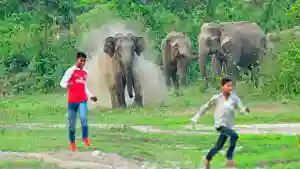Zimbabwe Parks and Wildlife Management Authority (ZimParks) spokesperson, Tinashe Farawo, has said there were 15 deaths and 43 injuries due to human-wildlife conflict in the first three months of 2023. Last year during the same period, there were 22 deaths and 18 injuries.
Zimbabwe has too many elephants, with around 84 000 exceeding the country’s carrying capacity of 45 000. The ban on the trade in wildlife products and species in Southern Africa has contributed to the ballooning elephant population.
This has caused an increase in human-wildlife conflict. The elephants are coming into human settlements in search of food and water, causing problems. Farawo said more distress calls were also received this year compared to last year. ZBC News cites him as saying:
We have noticed a slight decline in terms of people who have been killed by wild animals from last year. Last year we lost about 22 lives in the first quarter and this year we are at 15. The numbers still remain high if you consider instances that we are still recording. Last year we managed to translocate about 95 animals and this year we have already trans-located 150 animals. This is a way of dealing with human-wildlife conflict within our community. There are also cattle, donkeys and goats that were also killed by wild animals. We will continue to engage communities, teaching them about animal behaviour, and what needs to be done with certain species. We are always on the ground and we are also working with a lot of Rural District Councils to which we have given appropriate authority, so it’s not only the Zimbabwe Parks and Wildlife Authority which needs to react to this problem.
Traditional leaders from Chief Shana’s area are worried about the threat of human-wildlife conflict to food security in Hwange District. Village Head, Amos Tolani, from Jabula Village-Chief Mvuthu, said that baboons are destroying their crops, despite good results from the Pfumvudza/Intwasa program in the 2022/23 season. They are calling on Zimparks to relocate problem animals deep into national parks, compensate victims of human-wildlife conflict, pay medical bills, and increase the number of scouts or game rangers in each ward to react quickly if wild animals are seen in communities.
The pending Kavango Zambezi (KAZA) Elephant Aerial Survey results could provide proof that Southern African countries’ appeal to lift the ban on ivory and wildlife species trade is genuine.
A total of 66 people were killed by wild animals last year, down from 68 the year before. However, authorities report that nearly 400 people have died due to human-wildlife conflict in the past five years.

